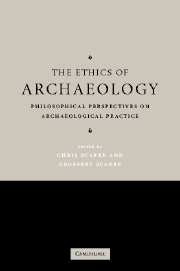Book contents
- Frontmatter
- Contents
- List of contributors
- Acknowledgements
- 1 Introduction
- PART I THE OWNERSHIP OF CULTURAL OBJECTS
- PART II ARCHAEOLOGISTS AND THE LIVING
- 6 Human subjects review and archaeology: a view from Indian country
- 7 Trust and archaeological practice: towards a framework of Virtue Ethics
- 8 Truthfulness and ‘inclusion’ in archaeology
- 9 Ethics and Native American reburials: a philosopher's view of two decades of NAGPRA
- 10 Stewardship gone astray? Ethics and the SAA
- PART III ARCHAEOLOGISTS AND THE DEAD
- PART IV THE COMMON HERITAGE OF HUMANKIND?
- References
- Index
7 - Trust and archaeological practice: towards a framework of Virtue Ethics
Published online by Cambridge University Press: 05 June 2012
- Frontmatter
- Contents
- List of contributors
- Acknowledgements
- 1 Introduction
- PART I THE OWNERSHIP OF CULTURAL OBJECTS
- PART II ARCHAEOLOGISTS AND THE LIVING
- 6 Human subjects review and archaeology: a view from Indian country
- 7 Trust and archaeological practice: towards a framework of Virtue Ethics
- 8 Truthfulness and ‘inclusion’ in archaeology
- 9 Ethics and Native American reburials: a philosopher's view of two decades of NAGPRA
- 10 Stewardship gone astray? Ethics and the SAA
- PART III ARCHAEOLOGISTS AND THE DEAD
- PART IV THE COMMON HERITAGE OF HUMANKIND?
- References
- Index
Summary
In the autumn of 1922, an English archaeologist sat in the damp darkness of an underground tunnel studying by candlelight the seal of the royal necropolis etched into a heavy stone doorway. After years of searching the deserts of Egypt in vain, he hoped, at last, that this was the object of his desire. Feverish with anticipation, the young archaeologist broke through the ancient stone and peered into the gaping space. ‘At first I could see nothing, the hot air escaping from the chamber causing the candle to flicker’, he would later write, ‘but presently, as my eyes grew accustomed to the light, details of the room emerged slowly from the mist, strange animals, statues, and gold – everywhere the glint of gold.’ When the archaeologist's companions, burning with curiosity, asked him if he could see anything, he replied in a whisper, ‘Yes, wonderful things.’
Howard Carter's discovery of Tutankhamun's tomb is fixed in the public imagination largely because of the spectacular material wealth found with the pharaoh's earthly remains (Carter 1923; Hoving 1978). Surely ‘King Tut’ would not be widely remembered today if Carter had only found a humble grave with a few undecorated ceramic sherds. Although most archaeologists oppose the popular stereotype of object hunter, they have built a professional identity that revolves around the possession and study of things. The museums around the world brimming with artefacts undeniably prove this point (Barringer and Flynn 1998).
- Type
- Chapter
- Information
- The Ethics of ArchaeologyPhilosophical Perspectives on Archaeological Practice, pp. 115 - 130Publisher: Cambridge University PressPrint publication year: 2006
- 22
- Cited by



